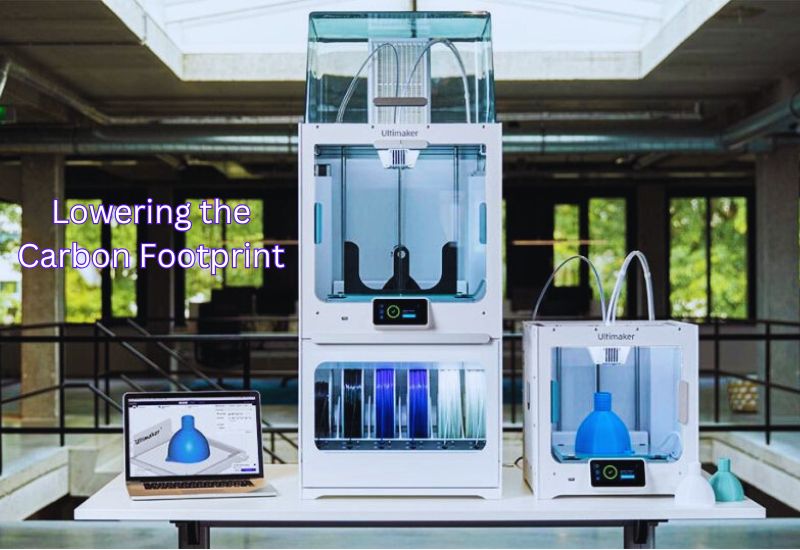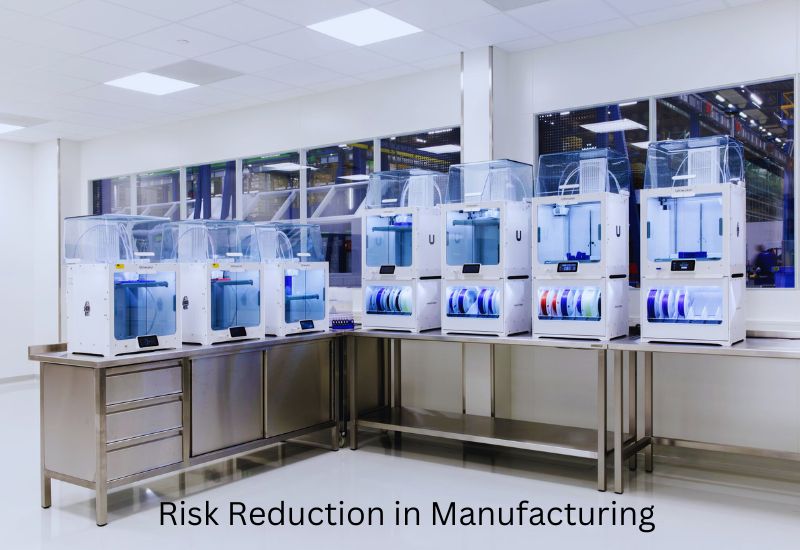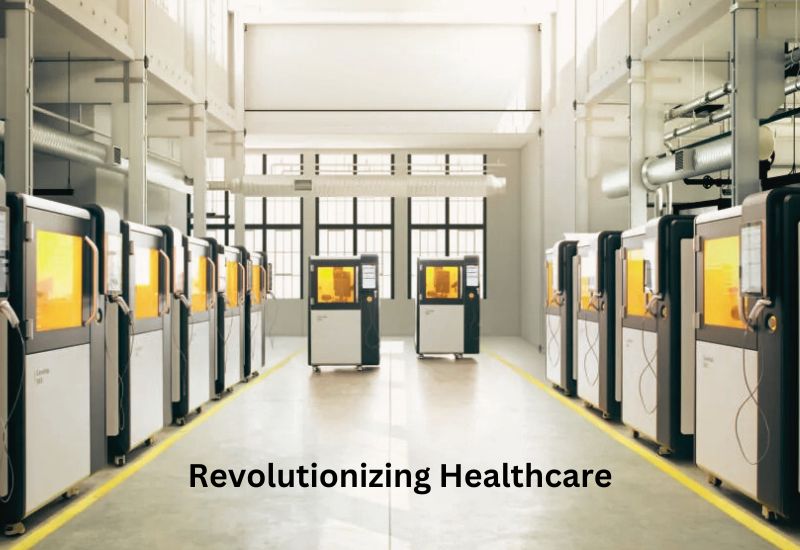Did you know that the global 3D printing market is expected to grow at a rate of 17.2 percent annually in 2024, reaching $4.3 billion? This ever-increasing industry is revolutionizing manufacturing, bringing efficiency in terms of time, cost, and offering unmatched design flexibility. In addition to being a hobby, 3D printing enables you to run mass production, whether for a commercial business or a private person. The possibilities are endless. Taking advantage of this mass production will help you find the best 3d printer for small businesses with its speed, accessibility, and positive impact on the environment.
Relevant Topic
Industrial & commercial uses
Large-scale printing
Professional printers

Faster Time to Market
How 3D Printing Speeds Up Prototypes and Products
Unlike traditional manufacturing, 3D printing efficiently converts a digital design into an object since no tooling stages are required. This makes mass production with 3D printing a more flexible and faster process. For example, a company developing custom phone cases created prototypes of the model in days rather than months, as it would take to make a conventional mold. Additionally, mass production with 3D printing can help resolve urgent problems, as seen during the pandemic outbreak when American companies needed ready-to-use face shields and ventilator components. It’s also being used for creative products like Portraits with a 3D Picture Printer, offering a personalized touch at scale.
Adapting Quickly to Market Trends
A 3D printer allows businesses to change direction quickly. For example, if a fashion brand has one product design one day, it can change it overnight without spending time or money retooling. The automotive and aerospace industries also utilize this feature to create complex designs rapidly. The short production cycle allows businesses to respond almost instantly to changing market needs. Additionally, mass production with 3D printing enables companies to produce large quantities of products efficiently while maintaining design flexibility.
The use of cutting-edge technology reduces tooling time, enabling businesses to completely transform the way they market their products.
Cost Efficiency in Mass Production with 3D Printing for Small Runs and Beyond
Saving Money on Prototypes and Low-Volume Production
High-tech digital fabrication is the foundation of 3D printing, which enhances manufacturing processes and eliminates traditional tool investments, such as heavy mold purchases. Since the forms are designed and printed on a computer, such expensive equipment is unnecessary, mainly when making low-volume designs, prototypes, and production runs. Additionally, 3D printing enables mass production, offering a cost-effective solution for scaling up production without the need for costly tooling. Carbon can be used to prove concepts or start businesses in specialized markets because it is cost-effective and adaptable.
Reduced Material Waste
3D printing creates a product one layer at a time, rather than carving material out of a single solid block. By reducing waste and conserving materials, manufacturing becomes more cost-effective and environmentally friendly. This method is also highly beneficial for mass production with 3D printing, as it allows businesses to produce large quantities of products more efficiently. For businesses, this means big savings and responsible efficiency when delivering goods.
Greater Design Freedom
Creating Complex Geometries Made Simple
There is no need for tooling or molds with 3D printing. Its layer-wise construction adds internal channels and lattice structures that are infeasible with injection molding or CNC machining, as it involves no tooling or molds. Aerospace engineers, for instance, utilize 3D printing to manufacture lightweight, complex components that enhance performance and efficiency. Moreover, 3D printing can be used for mass production, enabling manufacturers to produce large quantities of products with high precision and lower costs. This ability allows creators to create high-quality and accurate products based on their visionary concepts.
Customization at Scale
Prices are not driven up because custom-made items can be ordered through 3D printing. In addition to being inexpensive and easy to modify, anyone can customize prostheses or jewelry by providing a digital design file online. By substituting offbeat niche marketing for mass markets, companies maintained the effectiveness of mass production with 3D printing. Creating additive products eliminates the cost of mass customization, making it an appealing business idea. The ability to combine mass production with 3D printing allows businesses to offer personalized products without the high costs typically associated with traditional manufacturing.
On-Demand Manufacturing: Printing Products as Needed, When Needed
3D printing allows goods to be manufactured on demand, reducing inventory management and improving logistics. In contrast to standard production, which requires pre-purchase stocks due to expected demand, 3D printing can manufacture the exact number of products needed. This process is ideal for mass production with 3D printing, as it reduces the risks of overproduction and storage costs. By producing only what is needed, businesses can streamline operations and avoid unnecessary waste.
Flexibility is crucial when it comes to spare parts or small production quantities. With 3D printing, businesses can instantly print obsolete or special designs, minimizing downtime and improving customer satisfaction.
Saving on Warehousing Costs
In mass production using 3D printing, inventory must be maintained in large quantities, and storage spaces must be sufficiently large. This leads to high rent, utility bills, and personnel management costs. However, 3D printing, along with a just-in-time ordering system, helps reduce storage costs. Firms can place orders just in time, minimizing their need for large storage spaces and relying on the availability of raw materials to adjust quickly to market changes.

Environmental Benefits and Sustainability
Lowering the Carbon Footprint with Local Production
3D printing enables the manufacture of custom-made products locally, thereby reducing shipping costs. Consumers can also order products and pick them up at a local shop, eliminating the need for global logistics. Additionally, transportation is excessive, resulting in increased energy consumption during the manufacturing process. Mass production with 3D printing helps reduce the energy wasted in high industrial production plants, making it more environmentally friendly and efficient. Compact 3D printers also minimize waste, leading to more sustainable products.
Using Recyclable and Sustainable Materials
3D printing is more environmentally friendly because it uses biodegradable materials, such as PLA filament, derived from corn starch. PET is also widely used in recycling, replacing old plastic, and allowing entrepreneurs and enthusiasts to create their own items while limiting environmental damage. Mass production with 3D printing helps reduce waste by creating products on demand, further benefiting the environment.
The advantages of 3D printing include local and sustainable output, which allows creators to make their designs more affordable without harming the environment.
Improving Product Quality and Consistency in Mass Production with 3D Printing
Precision in Manufacturing
3D printing can produce highly accurate parts that match their CAD models because of its layer-by-layer approach. This approach eliminates numerous discrepancies associated with dated mass production practices for multifaceted and intricate designs. Mass production with 3D printing offers repeatability and accuracy in all prints, making it ideal for prostheses or any other alloy that requires specifications down to the last inch.
Real-Time Quality Control
Today’s 3D printers have monitoring systems that track every layer throughout the process. Any issues with uneven deposition and temperature variation are promptly identified and corrected, thereby reducing waste and enhancing product quality. This helps in mass production with 3D printing, ensuring fewer hitches and more quality work on time for businesses. DIYers also have confidence in their designs and speed, which reduces the number of failures.
3D printing addresses these challenges, elevating manufacturing standards across all projects while maintaining quality and consistency.
This table illustrates the reflection on Mass production using 3D printing.
| Aspect | Key Details | Impact |
| Precision in Manufacturing | – Layer-by-layer approach ensures consistent precision. | – Produces parts that match digital designs perfectly. |
| – Ideal for complex, detailed projects (e.g., prosthetics, high-performance parts). | – Guarantees repeatability and high accuracy with every print. | |
| Real-Time Quality Control | – Modern printers monitor each layer during manufacturing. | – Flags issues like uneven material distribution or temperature changes for immediate adjustments. |
| – Reduces waste and ensures superior final products. | – Results in smoother business operations and more successful DIY projects. | |
| Overall Benefits | – Ensures improved product quality and consistency across all applications. | – Elevates manufacturing standards for businesses and DIY creators alike. |
Accessibility for Small Businesses and Creators
Affordable Entry Point for Manufacturing
A desktop 3D printer is improving the manufacturing industry. These machines make producing goods easier and cheaper for small businesses and individuals. With models that cost less than $500, even those with limited resources can make professional products. Using these small, easy-to-use devices, one can create prototypes, small quantities of products, and bespoke tools, drastically reducing the initial investment cost and outsourcing levels. Businesses can easily modify their products by lowering shipping costs to align with market trends and remain competitive. Additionally, mass production with 3D printing enables companies to produce larger quantities efficiently, eliminating the need for expensive equipment or large factories.
Democratizing Innovation
3D printing allows designers to create, test, and produce goods, helping them compete with big corporations. It also allows small designers to develop, test, and produce goods. Customizing end-user products and niche market products is now possible. Self-made businesses can leverage this technology to innovate, test new ideas, and ultimately execute concepts that transform the existing market. With mass production through 3D printing, designers can scale their innovations more efficiently.

Risk Reduction in Manufacturing: Mass Production with 3D Printing
Testing Concepts Without Breaking the Bank
Rapid prototyping with 3D printing saves time and money while trying out concepts. Instead of purchasing costly conventional equipment, businesses can create workable models within days without incurring the expense of expensive equipment. In addition to lowering development costs, this flexibility enables design changes at the beginning of the development cycle, which also helps save time and money. Furthermore, mass production with 3D printing is possible, making it easier and more cost-effective to produce large quantities of items once the design is finalized.
Reducing Product Launch Failures
Using physical models, designers can identify problems and get user feedback before production begins. Companies can minimize the chances of recalls or canceled launches by evaluating how their products function and whether they are ready for Market. 3D printing can help companies develop better products and enable mass production, with 3D printing for faster and more efficient manufacturing.
This table highlights the advantages of Mass production using 3D printing.
| Benefit | How 3D Printing Helps |
| Testing Concepts Without Breaking the Bank | – Enables rapid prototyping to test ideas quickly. |
| – Reduces costs by avoiding expensive traditional tools. | |
| – Creates functional prototypes in days, improving flexibility. | |
| – Allows early design adjustments, minimizing waste and financial risk. | |
| Reducing Product Launch Failures | – Produces physical prototypes to identify design flaws. |
| – Facilitates user feedback to refine the product pre-launch. | |
| – Ensures functionality and market readiness through real-world testing. | |
| – Refining designs based on feedback lowers the risk of recalls or unsuccessful launches. |
Enhanced Supply Chain Efficiency
Shortening and Simplifying Supply Chains
3D printing allows companies to produce components near their customers in times of need, reducing their reliance on complex international distribution networks. By eliminating long waiting times and high shipping costs, this model reduces the need to hold large quantities of inventory. It also enables mass production with 3D printing, allowing small businesses to produce goods more quickly and closer to their customers, thereby minimizing the time and costs associated with a traditional supply chain.
Adapting to Material Shortages
3D printing enables companies to adjust quickly when materials are in short supply. For example, it is possible to use alternatives when a particular method becomes obsolete without having to purchase new machines. Medical tool manufacturers, for instance, used 3D printing during World War II. Thanks to their flexibility, firms can remain operational even when mainstream networks are down. Additionally, mass production with 3D printing enables companies to produce large quantities efficiently without the need for traditional manufacturing setups.
3D printing enhances domestic manufacturing while maintaining lean and flexible supply chains.

Exploring Niche and Emerging Use Cases for Mass Production with 3D Printing
Revolutionizing Healthcare
Personalized prosthetics and implants can further demonstrate the applications of 3D printing in healthcare. Using imaging techniques, patient-specific implants can also be created, which helps during accurate surgeries, allowing patients to recover quickly. Furthermore, prostheses created with a 3D printer can be manufactured rapidly and affordably, making them particularly appealing to young people. With mass production with 3D printing, these prosthetics and implants can be made more accessible and cost-effective. Bioprinting promises promising possibilities where organ donation queues may no longer be an issue. Doctors can also use them to practice performing complex operations.
Innovative Materials and Hybrid Production
Advanced lightweight materials, such as carbon fiber composites, made available through hybrid production methods, significantly support the aerospace and automotive industries. Cost-effective and tailored solutions can be achieved by combining 3D-printed parts with conventional methods, such as 3D injection molds. Combining 3D printing with contemporary and traditional materials expands the scope of innovation and market reach like never before.
Know More
FAQs for Mass Production with 3D Printing
1. Why is 3D printing great for mass production?
Its ability to reduce tooling costs, shorten production cycles, and enable customization benefits small—to medium-sized production runs.
2. Can 3D printing handle large-scale manufacturing?
Advancements like Multi Jet Fusion now allow for scalable production, making it effective for larger volumes.
3. How does 3D printing save money?
It eliminates the need for molds, minimizes material waste, and lowers costs for smaller batches.
4. Is 3D printing eco-friendly?
Yes, it generates minimal waste and supports localized production, reducing transportation emissions.
5. What industries benefit most from 3D printing?
Healthcare, automotive, and aerospace benefit greatly from its precision, customization, and lightweight capabilities.
6. Can 3D printing improve customization?
Absolutely. It enables on-demand production and tailored designs without extra cost.
Wrapping Up
3D printing has revolutionized the industry, offering cost-effectiveness, design freedom, and increased productivity. In addition to changing how things are manufactured, technology is also changing how innovation is viewed. It can suit any business or hobby with all its customization or sustainability solutions. 3D printing can be used to produce environmentally friendly and efficient products. Mass production with 3D printing is also becoming a reality, making it easier to create large quantities of products. Therefore, the question is not whether it should be adopted but what will be produced next.
Frequently Asked Questions
Does 3D printing reduce manufacturing costs?
Yes. Key savings come from eliminating the need for expensive traditional molds and tooling, especially for low-volume products. Additionally, it minimizes material waste by building objects layer-by-layer, using only the necessary material.
How does 3D printing provide “greater design freedom”?
It allows engineers and designers to create complex internal channels, intricate lattice structures, and specialized geometries that are impossible to manufacture using conventional techniques like injection molding or CNC machining.
Can I customize products on a large scale using 3D printing?
Yes, mass customization is one of its core strengths. Since production is driven by digital files rather than fixed molds, modifications can be made quickly and cheaply, allowing for individualized products (like patient-specific medical devices) without significant cost increases.
What is the environmental impact of using 3D printing for production?
3D printing lowers the carbon footprint by enabling local, on-demand manufacturing, which reduces the need for long-distance shipping. It also conserves material by reducing waste and supports the use of recyclable and biodegradable materials like PLA filament.
How does 3D printing improve quality control?
Modern 3D printers use a layer-by-layer process to achieve high precision that accurately matches CAD models. They also often include real-time monitoring systems to track and correct issues like temperature fluctuations or material inconsistencies during the printing process.
What happens to the supply chain with 3D printing?
It streamlines the supply chain by supporting a just-in-time, on-demand model. This reduces the need for large inventory warehouses, lowers storage costs, and increases a company’s ability to adapt quickly to material shortages or changes in market demand.
